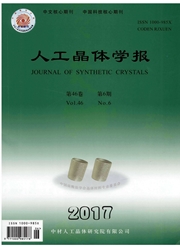

 中文摘要:
中文摘要:
多孔硅吸杂是减少晶体硅中杂质和缺陷,提高太阳能电池转换效率的有效方法。本文采用电化学腐蚀方法在单晶硅片上制备多孔硅。通过观察多孔硅的形貌、孔隙率、多孔层厚度及单晶硅片的电阻率变化,研究不同的腐蚀时间对制备多孔硅的吸杂效果的影响,并分析多孔硅吸杂的机理。结果表明,在J=100mA/cm2条件下腐蚀时间为30min、40min、50min、60min吸杂处理后,电阻率均提高,且随着腐蚀时间的增加,电阻率相应增加,与多孔硅的形貌、孔隙率和多孔层厚度的变化趋势一致。多孔硅形成伴随弹性机械应力出现,随腐蚀时间增加,应力增加,晶格常数相应增加,这都有利于缺陷和金属杂质在多孔硅层一基底界面处迁移和富集,导致单晶硅吸杂后电阻率增大。
 英文摘要:
英文摘要:
Porous silicon gettering is an effective way to reduce impurities and defects in crystalline silicon to improve the conversion efficiency of solar cells. In this paper, porous silicon was prepared on monocrystalline silicon wafers by electrochemical etching method. The impact of the different electrochemical etching time for the preparation of porous silicon gettering effect was studied and mechanism of the porous silicon gettering was analyzed by observing the morphology, porosity of the porous silicon, the thickness of the porous layer and the resistivity change of monocrystalline silicon wafers. The results showed that the resistivity of silicon wafers are improved with etching time of 30 min, 40 min, 50 min and 60 min under the current density of 100 mA/cm2 after gettering treatment and with the etching time increasing, the resistivity increases which coincides with the result of morphology and porosity as well as the thickness of the porous silicon layer. The elastic mechanical stress is formed along with the formation of the porous silicon, and the stress and lattice constant increases with increasing the etching time, which promotes the migration and enrichment of the defects and metal impurities at the interface of the silicon substrate and porous silicon layer thus leading to the increasing of resistivity in monocrystalline silicon after gettering.
 同期刊论文项目
同期刊论文项目
 同项目期刊论文
同项目期刊论文
 Removal of aluminum and calcium in multicrystalline silicon by vacuum induction melting and directio
Removal of aluminum and calcium in multicrystalline silicon by vacuum induction melting and directio Research on the Influence of Electron Beam Parameters on Molten Pool Morphologies during Electron Be
Research on the Influence of Electron Beam Parameters on Molten Pool Morphologies during Electron Be Effect of tin addition on primary silicon recovery in Si–Al melt during solidification refining of s
Effect of tin addition on primary silicon recovery in Si–Al melt during solidification refining of s Effect of the Silicon Nitride Coating of Quartz Crucible on Impurity Distribution in Ingot-Cast Mult
Effect of the Silicon Nitride Coating of Quartz Crucible on Impurity Distribution in Ingot-Cast Mult 期刊信息
期刊信息
